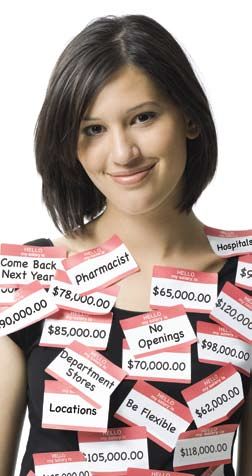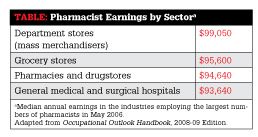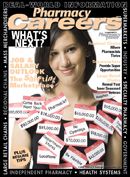Publication
Article
Pharmacy Careers
Job and Salary Outlook: The Shifting Marketplace
Author(s):
In this economy, pharmacy jobseekers may be approaching their search with some trepidation and rightly so. Forecasts for the health care sector project both short- and long-term job growth, but where does pharmacy fit into that picture? Many observers say the once-touted “pharmacist shortage” is over—at least for now—in many parts of the country. Yet armed with the right attitude, the next cohort of PharmDs should be able to find a well-paying job in their chosen field.

“Right now, in this climate, employers have the edge, and they are being very, very selective,” explains Donna M. Feudo, RPh, professional experience director and clinical professor with rutgers University’s Ernest Mario School of Pharmacy in New Jersey. “Two years ago, many graduates would be offered generous sign-on bonuses, but students can no longer go into the interview expecting one for positions in the state of new Jersey.” She notes that when her department surveyed the 2009 graduating class last march, 40% responded that they did not yet have a position secured upon graduation; in previous years, graduates had no difficulty whatsoever.
The Supply—Demand Puzzle
Feudo attributes the change in climate to a number of factors, including fewer new store openings and companies taking a very close look at their budgets in a weak economy, though shortages do exist in some areas of the country. The June 2009 Aggregate Demand Index, supported by Pharmacy Manpower Project Inc, estimates National Pharmacist Demand at 3.69, meaning that the demand for pharmacists is more or less in balance with supply (scale: 5 = high demand with difficult-to-fill open positions; 1 = demand is much less than the pharmacist supply available). Highest unmet demand was reported in Wisconsin (4.80) and the westsouth-central division (Arkansas, Louisiana, Oklahoma, and Texas); states with the lowest level of demand were in New England.
Government projections bear these figures out. the federal Health Resources and Services Administration, in its report on the adequacy of the pharmacist supply from 2004 to 2030, noted that, “the supply of pharmacists is growing significantly faster than previously projected,” and identified only a “moderate shortfall of pharmacists.” The agency pointed out that geographic disparities in access to pharmacist services exist in hard-to-employ locations, such as rural areas and low-income urban areas, however. At the same time, the Bureau of Labor Statistics, in the 2008-2009 edition of its Occupational Outlook Handbook, is forecasting employment of pharmacists to grow by 22% between 2006 and 2016—a rate it says is much faster than the average for all occupations.
Where Do I Fit In?
What is a soon-to-be PharmD to make of all this? How does one proceed in an environment of shifting job prospects? First, Feudo recommends that students distinguish themselves, do their homework, research the companies, and— most important—take advantage of work and outreach experience opportunities. Feudo says that when her students participate in such activities as immunization and diabetes education, smoking cessation programs at high schools, and poison prevention programs at elementary schools, it really fleshes out their résumés and helps candidates to stand out with potential employers. Getting involved in advocacy work, with the American Pharmacists Association, for example, is also a good idea, she suggests.
Feudo (who has a human resources [HR] background herself) says that HR professionals are looking for problem-solving skills, initiative, and motivation. Finally, she advises students to be flexible. When recruiters came to the school of pharmacy’s campus in February, the job openings in New Jersey were limited. “Be willing to move, perhaps to a neighboring state. Having that second license will really help.”

The Bureau of Labor Statistics reports a median annual salary for pharmacists of $94,520 (Table). Rutgers’ Donna Feudo, RPh, says that the major chains are paying, on average, about $50 to $52 per hour for an average workweek of 30 to 45 hours. She said that with a 30-hour workweek, pharmacies can hire more pharmacists and then have the flexibility to offer increased hours, as needed, by having the capacity under one roof.
The Department of Labor’s Women’s Bureau reports that pharmacy is the top-paying career choice for women with full-time median weekly earnings of $1647, coming in ahead of chief executives ($1603) and even lawyers ($1509). And, the field continues to attract women, many of whom are drawn by the opportunity to work part-time and still earn good money. In its 2008 Chain Pharmacy Employment Survey, the National Association of Chain Drug Stores found that of 22,978 pharmacists working part-time in chain community pharmacies, 64% were women and 36% men.







